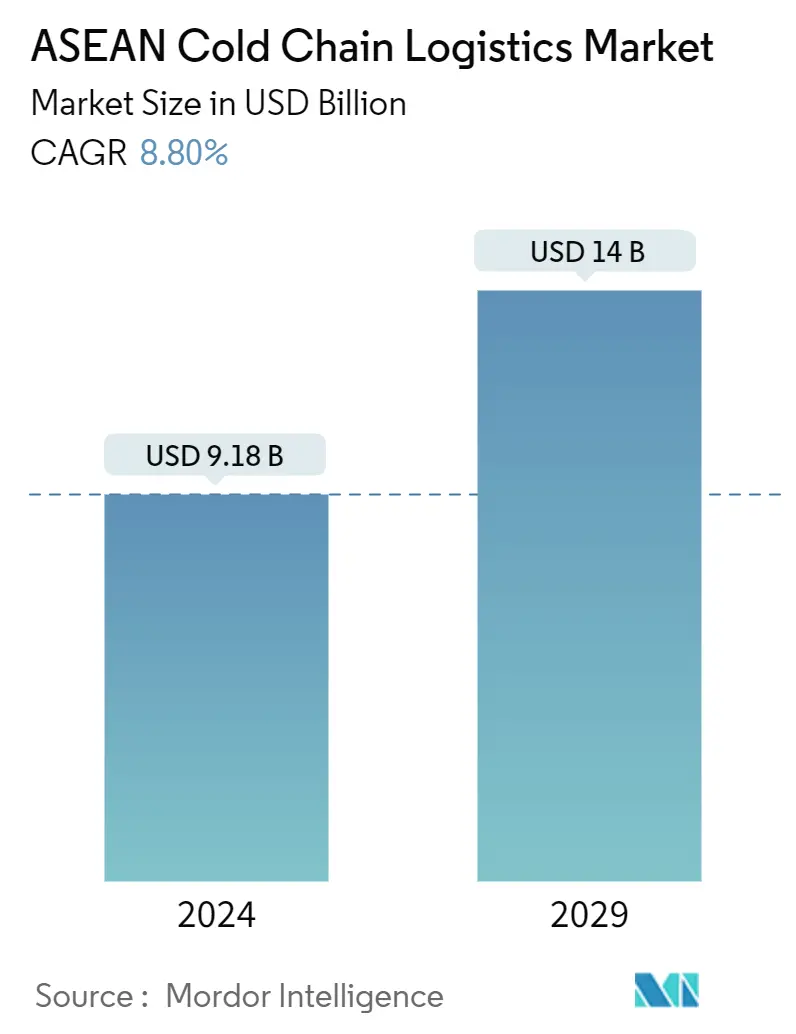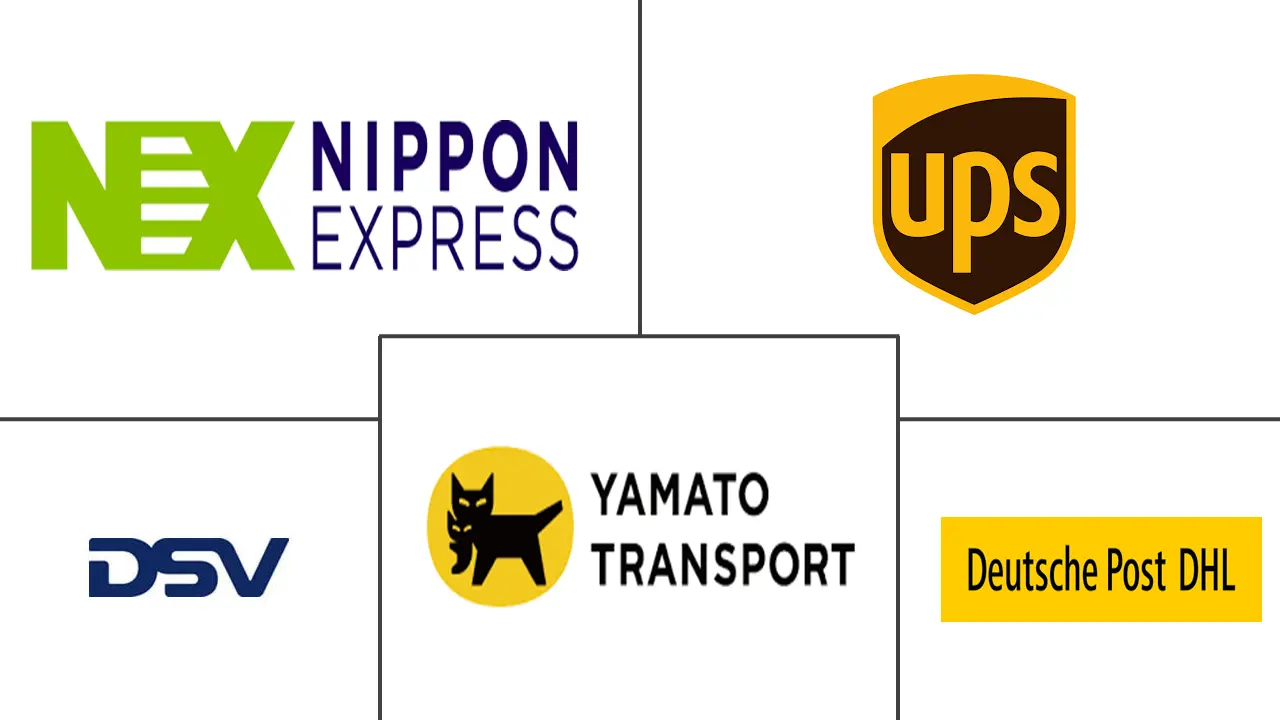Market Size of ASEAN Cold Chain Logistics Industry

| Study Period | 2020-2029 |
| Base Year For Estimation | 2023 |
| Market Size (2024) | USD 9.18 Billion |
| Market Size (2029) | USD 14 Billion |
| CAGR (2024 - 2029) | 8.80 % |
| Market Concentration | Low |
Major Players
*Disclaimer: Major Players sorted in no particular order |
ASEAN Cold Chain Logistics Market Analysis
The ASEAN Cold Chain Logistics Market size is estimated at USD 9.18 billion in 2024, and is expected to reach USD 14 billion by 2029, growing at a CAGR of 8.80% during the forecast period (2024-2029).
- The growing urban population and changing consumer perception have boosted refrigerated storage and transport demand. The market for refrigerated/frozen products is rapidly growing in Southeast Asia.
- The distribution of food products is rapidly shifting from traditional markets toward supermarkets and convenience stores. Refrigerated and frozen products are easier to procure, as major distributors offer shipping via insulated trucks.
- The quality of local cold-chain services varies widely. Food products have been damaged due to the lack of refrigeration. It is estimated that 90% of Southeast Asia's food waste is created during transport.
- Indian cold chain business is still in its early stages, it is one of the most promising industries in the cold chain warehousing and logistics industry.
- By 2027, India will have the world's fifth-largest economy. Investment in India's supply chain infrastructure is likely to increase year on year since it is a well-established, important player in the global market.
- Fortunately, the Indian government is a driving factor in the development of the cold chain industry, encouraging private participation through a variety of subsidy programs and incentives. The Ministry of Food Processing Industries (MoFPI) has initiated a cold chain, value addition, and preservation infrastructure program.
- Rising income levels in ASEAN countries and lifestyle changes are key factors for the growth of meat consumption and production in these regions. Indonesia and Vietnam are mainly driving the growth.
ASEAN Cold Chain Logistics Industry Segmentation
Cold chain refers to temperature-controlled logistics procedures. A complete background analysis of the ASEAN Cold Chain Logistics Market, including the assessment of the economy and contribution of sectors in the economy, market overview, market size estimation for key segments, and emerging trends in the market segments, market dynamics, and geographical trends, and COVID-19 impact is included in the report.
The ASEAN cold chain logistics market is segmented by service, temperature, and geography. By service, the market is segmented by storage, transportation, and value-added service. By temperature, the market is segmented into ambient, chilled, and frozen. By application, the market is segmented into horticulture, dairy products, meats and fish, processed food products, pharma, life sciences, chemicals, and other applications, and by geography, the market is segmented by Singapore, Thailand, Vietnam, Indonesia, Malaysia, Philippines and Rest of ASEAN.
The report offers market size and forecasts for the ASEAN cold chain logistics market in value (USD) for all the above segments.
| By Service | |
| Storage | |
| Transportation | |
| Value-added Services (Blast Freezing, Labeling, Inventory Management, etc.) |
| By Temperature | |
| Ambient | |
| Chilled | |
| Frozen |
| By Application | |
| Horticulture (Fresh Fruits and Vegetables) | |
| Dairy Products (Milk, Ice-cream, Butter, etc.) | |
| Meats and Fish | |
| Processed Food Products | |
| Pharma, Life Sciences, and Chemicals | |
| Other Applications |
| By Geography | |
| Singapore | |
| Thailand | |
| Vietnam | |
| Indonesia | |
| Malaysia | |
| Philippines | |
| Rest of ASEAN |
ASEAN Cold Chain Logistics Market Size Summary
The ASEAN cold chain logistics market is experiencing significant growth, driven by increasing urbanization, rising incomes, and changing consumer preferences in Southeast Asia. The demand for refrigerated storage and transport is on the rise, particularly as the distribution of food products shifts from traditional markets to supermarkets and convenience stores. This shift is facilitated by major distributors offering shipping via insulated trucks, although the quality of local cold-chain services varies, leading to substantial food waste during transport. The Indian cold chain industry, still in its nascent stages, is poised for substantial growth, supported by government initiatives and investments in supply chain infrastructure. The rising income levels and lifestyle changes in ASEAN countries are also contributing to increased meat consumption and production, with Indonesia and Vietnam playing pivotal roles in this expansion.
The ASEAN region is witnessing a burgeoning demand for halal food products, driven by the growing Muslim population and increased awareness of halal-certified products among consumers. This demand is further fueled by the rise in tourism from predominantly Muslim countries, creating a need for halal-certified restaurants and food products. Businesses in the region are actively pursuing halal certification to tap into this lucrative market. The cold chain logistics market in ASEAN is characterized by a mix of global and local players, with significant investments from international companies to expand their presence. Japanese logistics firms are enhancing their activities by establishing transportation bases and investing in cold chain developments across the region. Strategic alliances and expansions by companies like YCH Group and DP World are further strengthening the logistical and supply chain capabilities in Southeast Asia.
ASEAN Cold Chain Logistics Market Size - Table of Contents
-
1. MARKET INSIGHTS
-
1.1 Current Market Scenario
-
1.2 Market Dynamics
-
1.2.1 Drivers
-
1.2.1.1 Increasing demand for cold chain logistics
-
1.2.1.2 Expansion of international trade in the region
-
-
1.2.2 Restraints
-
1.2.2.1 Lack of proper infrastructure and facilities
-
1.2.2.2 High cost associated to cold chain logistics
-
-
1.2.3 Opportunities
-
1.2.3.1 Growing demand for perishable goods
-
1.2.3.2 Technological advancements driving the market
-
-
-
1.3 Technological Trends and Automation in Cold Storage Facilities
-
1.4 Government Regulations and Initiatives
-
1.5 Review and Commentary on Role of Japan in the ASEAN Cold Chain Industry
-
1.6 Insights into Industry Value Chain
-
1.7 Industry Attractiveness - Porter's Five Forces Analysis
-
1.7.1 Threat of New Entrants
-
1.7.2 Bargaining Power of Buyers/Consumers
-
1.7.3 Bargaining Power of Suppliers
-
1.7.4 Threat of Substitute Products
-
1.7.5 Intensity of Competitive Rivalry
-
-
1.8 Impact of Emission Standards and Regulations in the Cold Chain Industry
-
1.9 Insights into Refrigerants and Packaging Materials Used in Refrigerated Warehouses
-
1.10 Insights into Halal Standards and Certifications in Indonesia and Malaysia
-
1.11 Insights into Ambient/Temperature-controlled Storage
-
1.12 Impact of COVID-19 on the Market
-
-
2. MARKET SEGMENTATION
-
2.1 By Service
-
2.1.1 Storage
-
2.1.2 Transportation
-
2.1.3 Value-added Services (Blast Freezing, Labeling, Inventory Management, etc.)
-
-
2.2 By Temperature
-
2.2.1 Ambient
-
2.2.2 Chilled
-
2.2.3 Frozen
-
-
2.3 By Application
-
2.3.1 Horticulture (Fresh Fruits and Vegetables)
-
2.3.2 Dairy Products (Milk, Ice-cream, Butter, etc.)
-
2.3.3 Meats and Fish
-
2.3.4 Processed Food Products
-
2.3.5 Pharma, Life Sciences, and Chemicals
-
2.3.6 Other Applications
-
-
2.4 By Geography
-
2.4.1 Singapore
-
2.4.2 Thailand
-
2.4.3 Vietnam
-
2.4.4 Indonesia
-
2.4.5 Malaysia
-
2.4.6 Philippines
-
2.4.7 Rest of ASEAN
-
-
ASEAN Cold Chain Logistics Market Size FAQs
How big is the ASEAN Cold Chain Logistics Market?
The ASEAN Cold Chain Logistics Market size is expected to reach USD 9.18 billion in 2024 and grow at a CAGR of 8.80% to reach USD 14 billion by 2029.
What is the current ASEAN Cold Chain Logistics Market size?
In 2024, the ASEAN Cold Chain Logistics Market size is expected to reach USD 9.18 billion.

